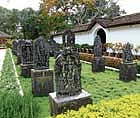

Not Shimoga but Shivamogga, my friend corrected me, when I mentioned an impending trip to this city in a conversation with her. This city was renamed along with several other towns/cities by the state government recently, she informed me. Shivamogga means buds of the flowers meant for Shiva. Later, I found that the word Shivamogga itself is derived from the words Shiva Mukha which is Sanskrit for the face of Shiva. Though some are of the opinion the city’s name can be traced to Sihi-Moge or sweet pot.
The etymology may be debatable but not the fact that the city’s Shivappa Nayak Palace and Museum are worth a visit. Located in the heart of the city, the palace and former-fort are named after its builder Keladi Shivappa Nayaka of the Keladi Nayaka kingdom.
The Keladi rulers succeeded the legendary Vijayanagar kings in the Malnad and coastal areas of Karnataka during the late 16th century and their reign lasted till the late 18th century when they fell to Hyder Ali’s forces. However, some books say the original builder of the palace was Hiriya Venkatappa Nayaka and that Shivappa later reconstructed the edifice which had been partly destroyed by the Bahmani king Adil Shah. Now, of course, the palace and fort form a ‘Protected Monument’ under the Archaeological Survey of India and a rather well-maintained one must say.
Sparsely furnished palace
The word palace conjures up visions of majestic structures and grand rooms with opulent décor, reeking of luxury. So, the Shivappa Nayaka Palace with its sparsely furnished wooden interiors and simple, landscaped gardens, was rather a surprise but not an unpleasant one at all. For one, there was the excitement of encountering something unexpected––an unusual royal residence. And the palace impressed with its symmetrical and beautiful teakwood architecture and its rich collection of sculptures dating back centuries, all as well-preserved as they were aesthetically displayed.
The entrance had a small garden with a sprinkling of antique statues before the entrance to the office building. After we skirted this entrance and moved left, we encountered the palace structure.
At first glance, it was remarkably reminiscent of the Tipu Sultan Summer Palace in Chamarajpet area of Bangalore with its Indo-Islamic architecture. There was an open courtyard with octagonal wooden pillars––over 20 feet in height––and two flights of stairs on either end which ended in an upper storey.
This area had two large rooms, 16 wooden pillars and a large balcony where school-kids were posing for pictures. We noticed an extensive use of rosewood and teak. We were told the large balcony seen in this upper storey was used to conduct durbars whenever the king visited the town.
Behind this was a large courtyard with scores of statues and a similar but much larger, neatly landscaped garden on its left but separated by a building.
Display of sculptures
Both these areas and the garden at the entrance contain sculptures recovered from the Hoysala, Chalukya periods, etc. They include figures of Ganesha, Narasimha, Mahishasuramardhini, Surya or the Sun God, Gajalakshmi, Vishnu in various poses, etc. There are antiques recovered from the Tavanandi fort, Baruru, Somapura, Saluru, Basavapatna, Kalkere, Annavati Forest, Gurupura, Balligave, Choradi Forest, etc. The idols of Ugra Narasimha, Jade Ganapathi, Yoganarayana (Mahavishnu in a yogic meditation posture), Durga and Anantasayana (Mahavishnu in a reclining pose) were among the most impressive.
Most sculptures were neatly labelled with name and date mentioned below in English and Kannada.
However, it did seem a pity that such antique treasures and an invaluable part of our temple heritage, have been exposed to the elements in the two gardens. Only the sculptures in the central courtyard have a roof overhead for protection from rain though the sun does stream through this covering.
The roofs of the buildings here were covered with Mangalore tiles and are sloping––understandable given that this region is known for its heavy rainfall. The river Tungabhadra is nearby, explaining why this location was chosen for the construction of the king’s residential quarters.
How to get there
Shimoga town is easily reachable by train and road from Bangalore in an approximate six-hour journey. The Shivappa Nayaka Palace there is in a busy area of the city.
There are other things to check out in and around Shimoga once you have done with the palace.
Chikmagalur: A picturesque region with lush coffee-plantations. Conducted plantation tours help you learn all about the making of coffee. Shop for coffee-seeds/powder honey, coffee-wood furniture and other local produce.
Matthur Sanskrit Village: It’s famous as a place where Sanskrit is a living, widely spoken language.
Jog Falls: A stunning waterfall.
Sakrebylu Elephant Camp: Especially delightful for children.
Tyavarekoppa Lion and Tiger Safari: This is wildlife-viewing with guaranteed sighting of lions, tigers and plenty of deer, sambar, etc., as you are taken around in a safari van.
Amruthapura: An interesting Narasimha temple with Hoysala architecture.
Bhadra Wildlife Sanctuary and Tiger Reserve: This wildlife sanctuary which is also a site for Project Tiger houses a wide range of wildlife like tiger, elephants, gaur, leopard, sloth bear, langurs, Malabar Giant Squirrel, Large Brown Flying Squirrel, Blacknapped Hare, etc.
Bhadra is a big attraction for birdwatchers and the big draw is the thousands of river-terns found here during the summer and monsoon months, which nest in the islands dotting the Bhadra reservoir.
Kemmanagundi: A small and picturesque hill-station nearby.
